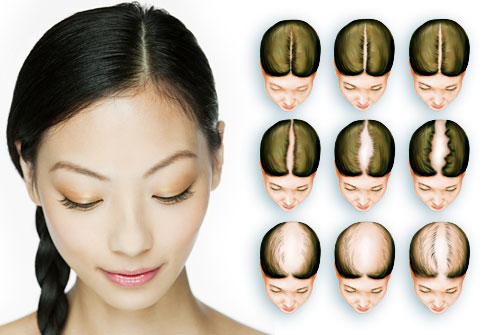
There are several things that trigger hair loss, including our genetic make-up, diet, hormonal changes within the body, medication, illness, infection, or chemicals. All these things have the potential to stop hair from being formed properly.
Hair depicts style and personality in women. Unfortunately, 40% of people who go through temporary or long-term hair loss are women.
Female pattern hair loss (FPHL) is the commonest cause of hair loss in women. It is characterised by decrease in hair density over the frontal scalp and crown while retaining the frontal hairline.
DID YOU KNOW?
- Hair loss is most commonly encountered post menopause, but it may begin as early as puberty
- Only 43% of women aged 80 years and over fail to show any sign of hair loss
- Hair loss can ensue post pregnancy or after stoppage of birth control pills
- It has larger effect on women compared to men, as it’s less socially acceptable
- Hair loss can lead to low self-esteem and depression among women
CAUSES OF HAIR LOSS IN WOMEN
The cause for female pattern baldness is thought to be related to aging, hormones and genetics. It can be a result of strong genetic predisposition. Another factor that contributes is hormones. With changes in the androgens (male hormones) after menopause, many women feel that the hair on their head is thinning.
Scalp hair is also sometimes damaged by cosmetic procedures like prolonged traction, permanent weaving, colouring, shampoo, soap, including faulty scalp massage, iron-deficiency anaemia, thyroid problems and polycystic ovarian disorders.
Certain conventional medications may also cause diffused hair loss. Short-term hair loss may occur in women taking oral contraceptive pills.
SYMPTOMS OF FEMALE PATTERN BALDNESS
In female pattern baldness the symptoms are:
- Hair primarily on the top and crown of the scalp thins, which generally begins with a widening through the centre hair part
- The front hairline remains intact besides normal recession
- The hair loss seldom advances to complete baldness.
Additionally, there are three different pattern of hair loss seen, which are:
- Diffuse thinning of the crown region with conservation of the frontal hairline
- Frontal midline recession with thinning and widening of the central part of the scalp without diffuse hair loss
- Thinning associated with bitemporal recession, which looks similar to male pattern baldness
- Thinning occurs on the side and on the top of the scalp.
HOMEOPATHIC TREATMENT FOR HAIR LOSS IN WOMEN
Homoeopathy is safe and has proven efficacy in treating hair and scalp problems in women. Homoeopathy aims to treat the whole person, depending on a multitude of factors, such as the personality of the individual, their state of mind and lifestyle rather than just the physical or apparent symptoms.
Research papers have demonstrated that homeopathic medicines counteract the effects of DHT (Dihydrotestosterone) by controlling the progression of hair loss without any side effects. It has also showed that homeopathic remedy Thuja is effective in controlling hair loss.
Homeopathic remedies may help in hair loss cases in women that occur in certain stages of life. For example, Pulsatilla works in cases of hair loss during puberty. Likewise, Sepia works in post delivery hair loss and Baryta Carb works well in childhood hair loss.
SELF-CARE TIPS
These tips may help control or prevent hair loss:
- Wash hair regularly with lukewarm to cold water to keep the scalp clean and healthy – but avoid it too frequently
- Condition hair regularly to prevent hair loss due to breakage
- Avoid rubbing wet hair vigorously with a towel – just gently pat them dry
- Opt for a nutritious balanced diet
- Avoid tight hairdos
- Avoid red meat
- Avoid extreme dieting
- Add iron rich food in your diet like poultry, seafood, beans, dark green leafy vegetables, such as spinach, dried fruit, such as raisins and apricots
- Treat hair gently while washing and brushing
- A wide-toothed comb can help prevent pulling out hair
- Avoid harsh treatments such as hot rollers, curling irons, hot oil treatments and permanents.
